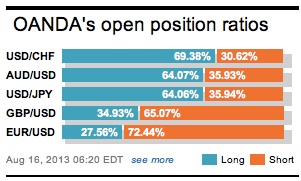The object is to remain in one piece so as to fight another day. This week’s current market price action is not for the faint of heart. Whiplash volatility has very much been the order of the day as we complete the final trade session to end this week. Come Monday; let’s hope both liquidity and volatility will be better measured as most of Europe is expected to return from their annual holidays. So far with so much riding on the Fed’s next move and economic data painting a mixed picture of the US recovery, the market does not seem to have any strong convictions. Of late, investors have been very quick to get out of positions causing increased volatility.
Global sentiment remains dominated by the speculation over the timeline of the Fed’s move to reduce its bond-buying program after yesterday’s US initial jobless claims fell to a multi year low and after other data showed that US consumer price index rose for a third straight month last month. All along, Fed officials have been saying that they require signs of higher inflation, coupled with other indicators of a stronger US economy, before they decide to reduce any part of the current $85b monthly bond-buying program.

Current market risk appetite has been deteriorating on the back of tapering fears heating up. Both global equities and US treasury prices have come under some intense pressure as investors try to calibrate the net effect of reducing the Fed’s stimulus. Yesterday’s US weekly jobless claims declined to +320k, the lowest level in six-years. The fear of the Fed’s QE tapering happening has global bond yields on the back foot, aggressively rallying. Weaker US earnings reports along with the violent scenes out of Egypt has been hurting global stock markets. Even signs that the Euro-zone is dragging itself out of recession with Q2 GDP rising +0.3% has been unable to help equities. All of this has allowed gold to reassert itself as an alternative investment vehicle to both bonds and equities. The yellow metal has rebounded just under +13% from its recent trough print at the end of June. Like a good commodity should do, the yellow metal is again supporting the commodity sensitive currencies like the Aussie and Loonie to a degree.

The mighty dollar has managed to decline from its weekly highs against its major trading partners as speculation that the Fed will begin its “taper terror” reign next month. A tighter monetary policy is weighing on the demand for assets denominated in the US currency. The “dominant” buck has reversed most of this weeks gain against both the EUR and JPY as stocks fall and Treasury yields touched two-year highs (US 10’s +2.77%). Even GBP has managed to climb to a two-month high outright after U.K. retail sales rose more than forecasted this week. Over time, the combination of a strong US economy and higher US yields should favor the greenback. However, until the market does buy into this scenario the weaker long dollar positions will be tested.

Data earlier this morning revealed that the Euro-zone current account surplus declined in June amid a narrowing of the member countries trade surplus. The surplus dropped to €16.9b after the previous months downwardly revised €19.5b. The bloc recorded a trade surplus of €11.8b in June. A tepid global demand for Euro products continues to hold back export growth. The 17-member region will have to rely on their own customer base to spend and buy their way into sustainable growth. With the regions high unemployment rate its no mean feat.

Ahead of US housing starts, building permits, consumer sentiment and buybacks, the USD is little changed from yesterday evening price levels against its major trading partners. Geopolitical risk is dominating the oil agenda with events in North Africa and Middle East providing solid support for crude prices. If you include the inflation pressures in the US then gold prices too should want to push higher for the time being. When tapering question truly takes center stage, not until then will this advance consider reversing its course.

Other Links:
Sterling’s Flight Of Fancy Keeps EUR In Check
Dean Popplewell, Director of Currency Analysis and Research @ OANDA MarketPulseFX
This article is for general information purposes only. It is not investment advice or a solution to buy or sell securities. Opinions are the authors; not necessarily that of OANDA Corporation or any of its affiliates, subsidiaries, officers or directors. Leveraged trading is high risk and not suitable for all. You could lose all of your deposited funds.


